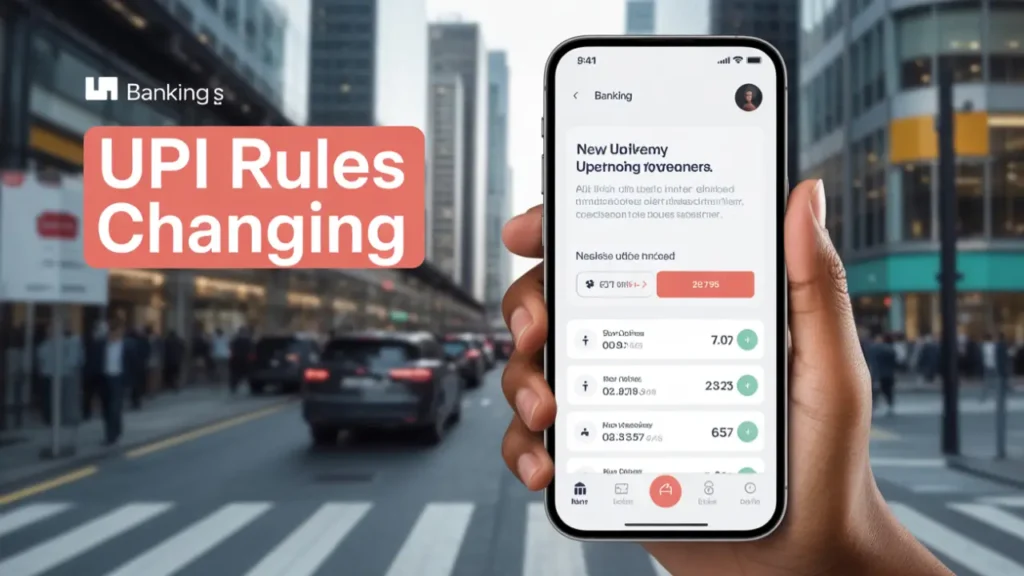The National Payments Corporation of India (NPCI) has rolled out a set of new rules for UPI (Unified Payments Interface) transactions, focusing on enhancing system performance, curbing fraud, and managing peak-time load. These changes, now officially in effect, impact how users check balances, set up recurring payments, verify account details, and much more. With these reforms, NPCI aims to make the UPI ecosystem more efficient, safer, and reliable as digital payments continue to grow across India.
Let’s take a closer look at the major changes and what they mean for everyday users.

UPI Balance Checks & Linked Account Limits Introduced
Under the new rules, UPI users can check their account balance a maximum of 50 times per day per app. This only applies to manual balance inquiries—apps can no longer perform automatic background balance checks without user permission.
To reduce the need for repeated balance checks, banks must now automatically display the updated account balance after every successful UPI transaction. This not only streamlines user experience but also cuts down on server traffic during peak hours.
In another move to reduce server strain, requests to fetch bank accounts linked to a mobile number (List Account API) are now restricted to 25 per app per day. Apps must also obtain user consent for retrying failed attempts.
Recurring Payments (Autopay) Get Time Restrictions
Automatic UPI payments like OTT subscriptions, EMI debits, utility bills, or SIPs now have new time slots for execution. These recurring mandates can only be processed outside peak hours—specifically:
- Before 10:00 AM
- Between 1:00 PM to 5:00 PM
- After 9:30 PM
Each payment attempt is allowed only once initially, with up to 3 retries—meaning four total tries to complete the transaction. This helps reduce traffic during busy times and ensures a smoother experience for one-time users transacting during the day.
Tighter Security and Transaction Verification
Security has been given a major boost. From now on, before completing any transaction, users must see the registered name of the beneficiary and the transaction ID. This minimizes errors and prevents fraudulent transfers.
Further strengthening account security, any UPI ID inactive for more than 12 months will be automatically deactivated. This is meant to prevent dormant accounts from being misused by malicious actors.
Additionally, linking a new bank account to UPI will now involve stricter verification and authentication, making the system more robust and secure for first-time users or those changing banks.
Reduced Server Load & Faster API Response Goals
In a bid to improve system speed and reduce downtime, NPCI now mandates that API responses—like those for initiating and validating transactions—must be completed within 10 seconds, significantly down from the previous 30-second limit.
Other API-related changes include:
- Transaction status checks are now limited to three attempts per transaction, with each spaced at least 90 seconds apart.
- These changes aim to reduce unnecessary server pings that slow down UPI services during high-traffic hours.
Why This Matters to You
The NPCI’s updated UPI guidelines are not just about limits—they are about making UPI faster, safer, and smarter.
- Efficiency Boost: Time restrictions and limits ease pressure during peak usage hours (10:00 AM–1:00 PM & 5:00 PM–9:30 PM).
- Stronger Security: Mandatory display of beneficiary names, transaction IDs, and stricter verifications help prevent fraud.
- User Convenience: Automatic post-transaction balance updates and clearer transaction steps make everyday UPI usage simpler.
- System Reliability: Faster APIs and capped retries help reduce delays and failed transactions.
Conclusion
These rule changes mark a bold shift in how UPI operates—offering more structure, less confusion, and better protection for millions of users. While some may see the limits as restrictive at first, the automatic features introduced actually simplify the experience for most users.
As India continues to lead globally in digital payments, these updates are a strong signal of NPCI’s commitment to ensuring that UPI remains one of the most trusted and scalable payment systems in the world.
F.A.Q.
– What is the new daily limit for checking UPI balance?
You can manually check your account balance up to 50 times per day per UPI app. This limit does not include automatic balance updates, which will now be shown after each successful transaction.
– Can I still check the status of a failed UPI transaction multiple times?
You can check the status only 3 times per transaction, with at least a 90-second gap between each attempt to reduce server load and system delays.
– What happens if my UPI ID has been inactive for a year?
If a UPI ID linked to your mobile number is inactive for over 12 months, it will be automatically deactivated to prevent misuse or unauthorized access.
– Will I see the recipient’s name before sending money on UPI?
Yes. Under the new rules, you must see the beneficiary’s registered name and transaction ID before you confirm the payment. This helps ensure your money is sent to the correct person.
Also read:-